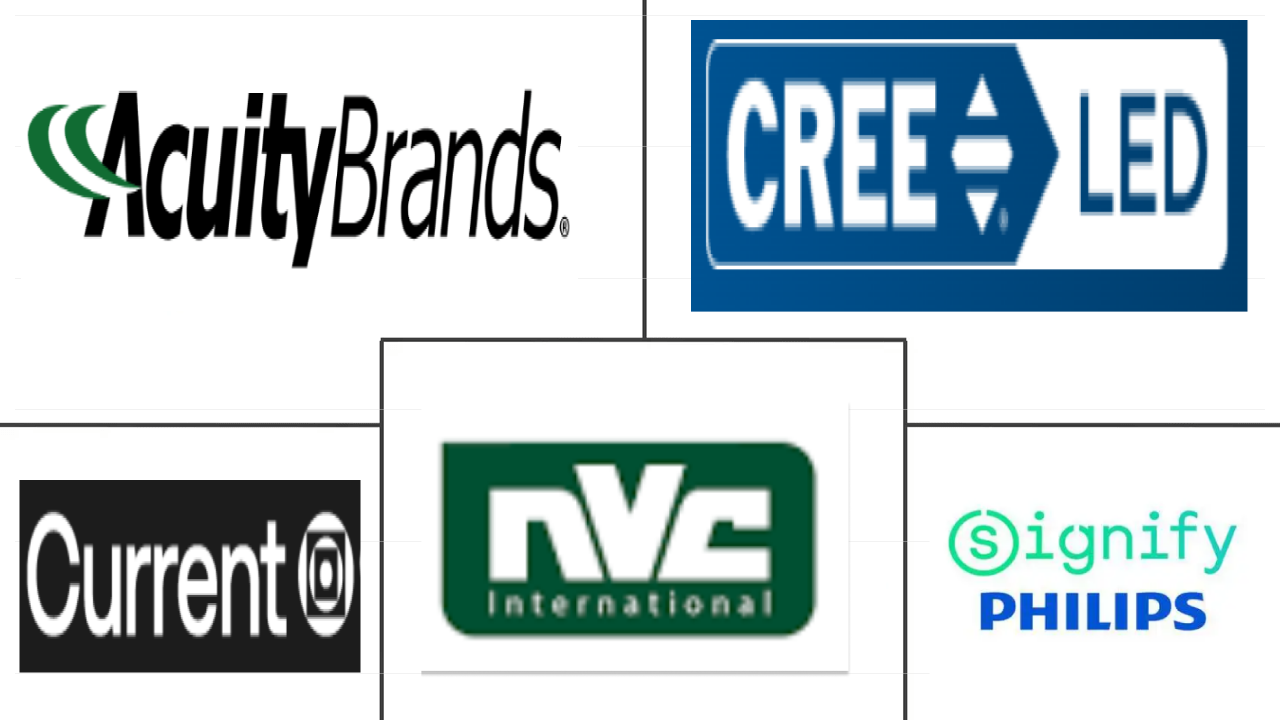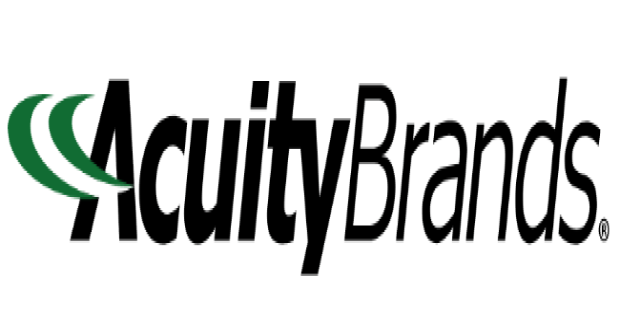Market Size of us indoor led lighting Industry
|
|
Study Period | 2017 - 2030 |
|
|
Market Size (2024) | USD 5.33 Billion |
|
|
Market Size (2030) | USD 6.49 Billion |
|
|
Largest Share by Indoor Lighting | Commercial |
|
|
CAGR (2024 - 2030) | 3.31 % |
|
|
Fastest Growing by Indoor Lighting | Industrial and Warehouse |
Major Players |
||

|
||
|
*Disclaimer: Major Players sorted in no particular order |
US Indoor LED Lighting Market Analysis
The US Indoor LED Lighting Market size is estimated at 5.33 billion USD in 2024, and is expected to reach 6.49 billion USD by 2030, growing at a CAGR of 3.31% during the forecast period (2024-2030).
5.33 Billion
Market Size in 2024 (USD)
6.49 Billion
Market Size in 2030 (USD)
1.11 %
CAGR (2017-2023)
3.31 %
CAGR (2024-2030)
Largest Segment by Indoor Lighting
65.29 %
value share, Commercial, 2023
In the United States, Canada was the largest foreign investor in commercial real estate, with cross-border flows of almost USD 19 billion in 2021.
Largest Segment by Commercial
30.58 %
value share, Retail, 2023
Retail sales in the United States grew significantly from USD 3 trillion in 2000 to nearly USD 6.6 trillion in 2021. Total retail sales grew by 8.9% Y-o-Y in 2022, indicating more use of LED lights in the country.
Fastest-growing Segment by Indoor Lighting
6.89 %
Projected CAGR, Industrial and Warehouse, 2024-2030
The cost of business logistics in the US amounted to more than USD 1.6 trillion in 2023, accounting for around 8% of the GDP, further promoting number of warehouses and industries.
Fastest-growing Segment by Commercial
4.54 %
Projected CAGR, Office, 2024-2030
The floor space of commercial buildings is projected to increase by 35% from 2021 to 2050, reaching a total of 124.6 billion meters by 2050. This indicates further usage of LED lights in offices.
Leading Market Player
45.90 %
market share, Acuity Brands Inc., 2022

Acuity Brands is one of the largest lighting manufacturers in the United States. The company is focused on expanding its lighting portfolio and geographic reach, which would thereby help the company strategically increase its customer base.
The increasing disposable income, government investments, and rising commercial construction in the region drive the growth of led lighting market
- In terms of value share, in 2023, commercial accounted for the majority of the share, followed by industrial and warehouse, and residential. The main factors contributing to the growth of the industrial sector's resilience are changes in labor force levels in China, less regulatory burden for US production than European counterparts, and greater vitality of manufacturing income relative to the United States Gross Domestic Product.
- In terms of volume share, in 2023, commercial accounted for the majority of the share, followed by the residential sector and industrial and warehouse sector. America's need for storage space is advancing toward a brighter future. With the acceleration of e-commerce, the warehousing industry may see more growth opportunities than ever. The US retail e-commerce sales in Q3 2020 are estimated at USD 209.5 billion. This is a 36.7% increase over Q3 2019.
- The construction industry is a growth industry in all areas. These include builders, contractors, and civil engineers in the private and commercial sectors. Employment in the construction and mining sector is expected to increase by 4% from 2019 to 2029, about the same rate as the average for all jobs. Part of the driver of this growth is the increasing demand for new buildings, roads, and other structures due to population growth.
- In 2022, there were 33.2 million small businesses in the United States. The five fast-growing startups are headquartered in San Francisco. 40% of US startups have at least one woman in leadership. Over 65% of small businesses reported profits in 2022. The above instances are expected to create more demand for Indoor LEDs in the coming years.
US Indoor LED Lighting Industry Segmentation
Agricultural Lighting, Commercial, Industrial and Warehouse, Residential are covered as segments by Indoor Lighting.
- In terms of value share, in 2023, commercial accounted for the majority of the share, followed by industrial and warehouse, and residential. The main factors contributing to the growth of the industrial sector's resilience are changes in labor force levels in China, less regulatory burden for US production than European counterparts, and greater vitality of manufacturing income relative to the United States Gross Domestic Product.
- In terms of volume share, in 2023, commercial accounted for the majority of the share, followed by the residential sector and industrial and warehouse sector. America's need for storage space is advancing toward a brighter future. With the acceleration of e-commerce, the warehousing industry may see more growth opportunities than ever. The US retail e-commerce sales in Q3 2020 are estimated at USD 209.5 billion. This is a 36.7% increase over Q3 2019.
- The construction industry is a growth industry in all areas. These include builders, contractors, and civil engineers in the private and commercial sectors. Employment in the construction and mining sector is expected to increase by 4% from 2019 to 2029, about the same rate as the average for all jobs. Part of the driver of this growth is the increasing demand for new buildings, roads, and other structures due to population growth.
- In 2022, there were 33.2 million small businesses in the United States. The five fast-growing startups are headquartered in San Francisco. 40% of US startups have at least one woman in leadership. Over 65% of small businesses reported profits in 2022. The above instances are expected to create more demand for Indoor LEDs in the coming years.
| Indoor Lighting | |||||
| Agricultural Lighting | |||||
| |||||
| Industrial and Warehouse | |||||
| Residential |
US Indoor LED Lighting Market Size Summary
The US Indoor LED Lighting Market is poised for significant growth, driven by increasing demand across various sectors. The commercial sector currently holds the largest share, followed by industrial, warehouse, and residential sectors. The market's expansion is supported by factors such as the resilience of the industrial sector due to favorable production conditions in the US compared to Europe, and the growing e-commerce sector boosting the warehousing industry. The construction industry also contributes to market growth, with rising demand for new buildings and infrastructure driven by population growth. Additionally, the increasing number of small businesses and the rise in disposable income further fuel the demand for indoor LED lighting, as consumers and businesses alike seek energy-efficient and cost-effective lighting solutions.
The market is characterized by a high level of consolidation, with major players like Acuity Brands Inc., Cree LED, Current Lighting Solutions, NVC International Holdings Limited, and Signify (Philips) dominating the landscape. These companies are continuously innovating, as evidenced by recent product launches such as Luminis's Inline series and Cree LED's J Series 5050C E Class LEDs, which offer enhanced efficacy and light output. The adoption of LED lighting is expected to increase significantly in both residential and commercial sectors, driven by energy efficiency and cost savings. Regulatory incentives, such as tax deductions for upgraded lighting systems, further support the market's growth trajectory, making LED lighting an attractive option for a wide range of applications across the United States.
US Indoor LED Lighting Market Size - Table of Contents
-
1. MARKET SEGMENTATION (includes market size in Value in USD and Volume, Forecasts up to 2030 and analysis of growth prospects)
-
1.1 Indoor Lighting
-
1.1.1 Agricultural Lighting
-
1.1.2 Commercial
-
1.1.2.1 Office
-
1.1.2.2 Retail
-
1.1.2.3 Others
-
-
1.1.3 Industrial and Warehouse
-
1.1.4 Residential
-
-
US Indoor LED Lighting Market Size FAQs
How big is the US Indoor LED Lighting Market?
The US Indoor LED Lighting Market size is expected to reach USD 5.33 billion in 2024 and grow at a CAGR of 3.31% to reach USD 6.49 billion by 2030.
What is the current US Indoor LED Lighting Market size?
In 2024, the US Indoor LED Lighting Market size is expected to reach USD 5.33 billion.

